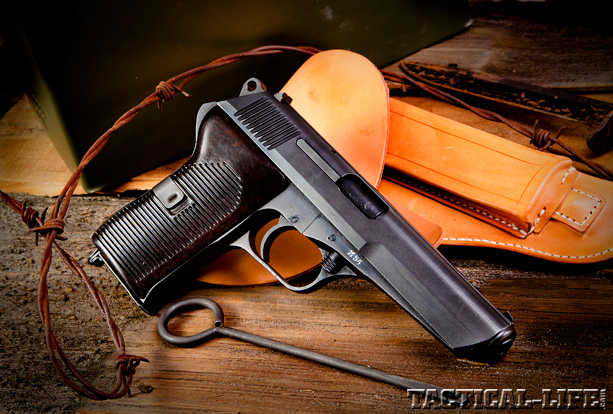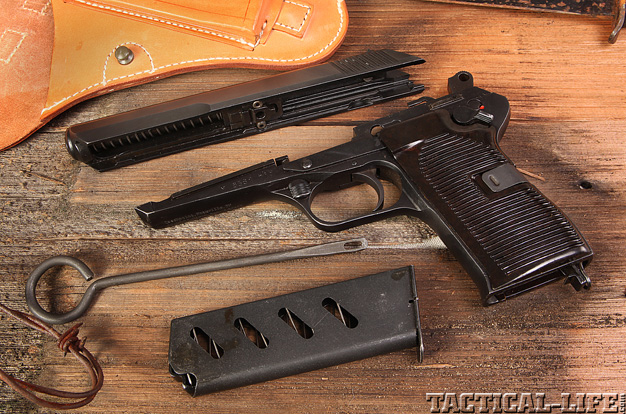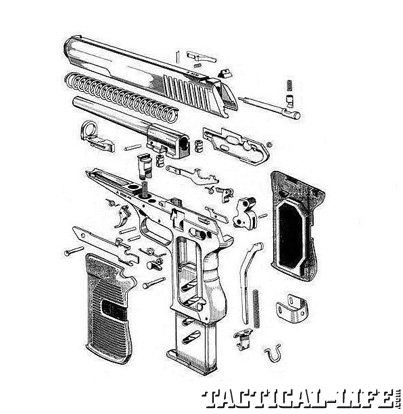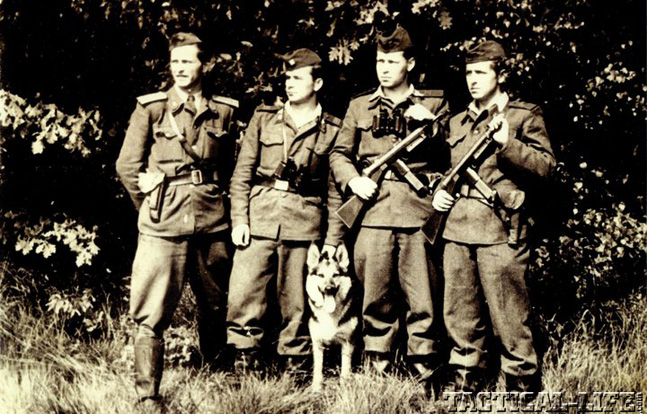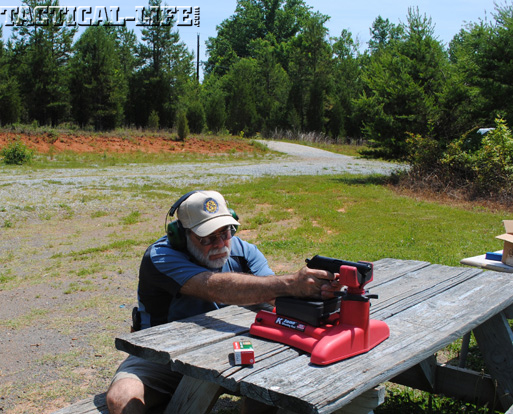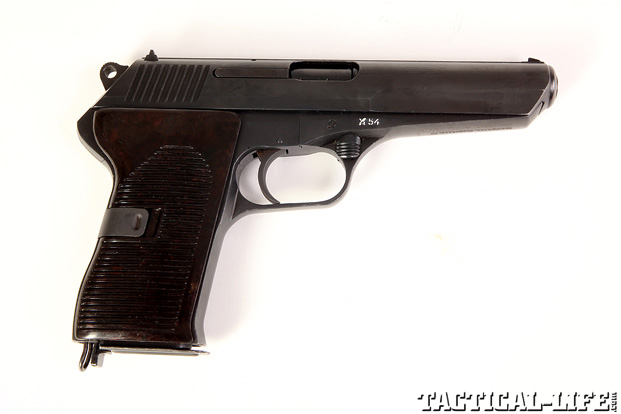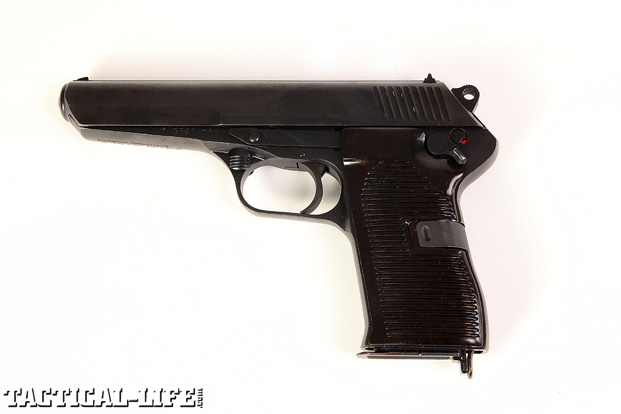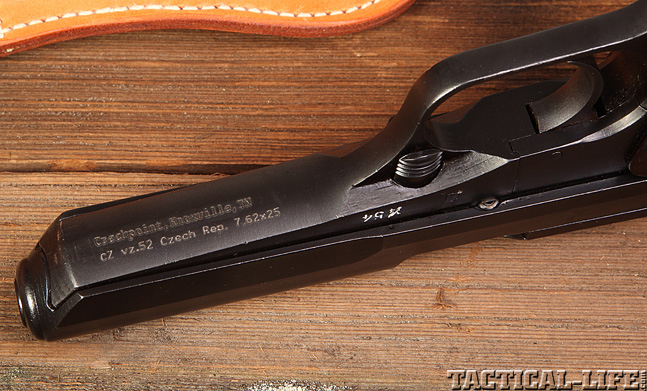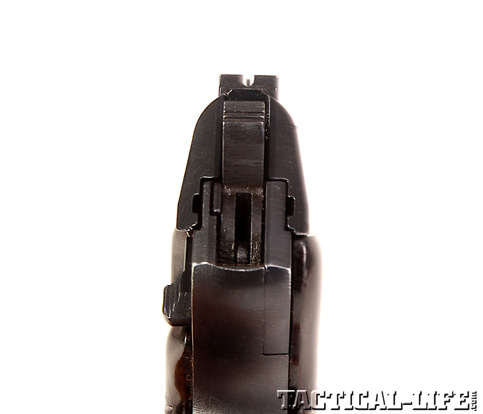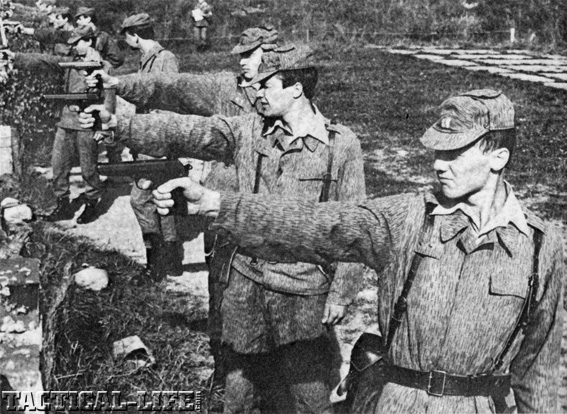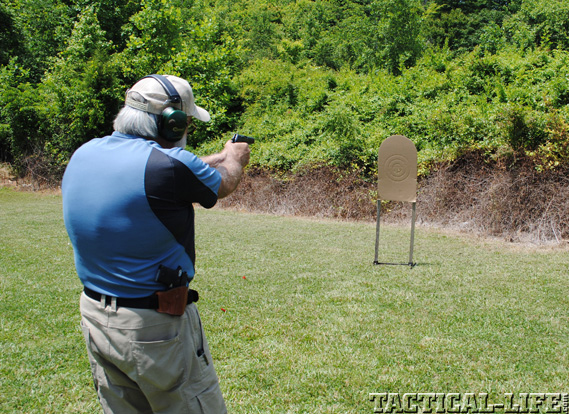The craftsmen of Czechoslovakia (now the Czech Republic) have a tradition of small-arms production dating back to the 17th century. After gaining their independence from the Austro-Hungarian Empire in 1919, they quickly became one of the world’s primary suppliers of small arms. In 1919, the Jihočeská Zbrojovka (South Bohemian Arms Factory) merged with the Hubertus Engineering firm to form the Ceská Zbrojovka (Bohemian Arms Factory), better known as CZ. Their first product was the Pistole vzor 22 (vzor means “model” in Czech) which used a rotating barrel system to lock the breech. In 1924, the Czech army adopted the CZ-designed Pistole vzor 24. While chambered for the 9mm nábojů vzor 24 (.380 ACP) cartridge it still used a rotating barrel locking system. Three years later, CZ introduced a blowback design, the Pistole vzor 27 chambered for the 7.65mm nábojů vzor 27 (.32 ACP), which was adopted by the Czech army and sold to police forces around the world.
During the German occupation from 1938 to 1945, the vzor 27 was manufactured for the Wehrmacht. Post-war production for the police and commercial markets continued until 1951, with over 500,000 vzor 27s ultimately leaving the factory. The post-WWII Czech army intended to replace the German and Soviet weapons in service with those of native design, but these plans were cut short by a 1948 coup that saw a communist government take power in Prague. Bowing to demands by the USSR for standardization of small arms, the Czechs agreed to adopt Soviet caliber cartridges but stubbornly clung to their tradition of using weapons of native design. While other Communist Bloc armies used the ubiquitous Soviet TT33 Tokarev pistol, the Czechs developed the 7.62mm Samonabíjecí Pistole vzor 52 (7.62mm semi-automatic pistol model 52, popularly known as the “CZ-52”).
Czech Vzor 52
The vzor 52 was designed by Jan and Jaroslav Kratchovil at the new CZ plant in Uhersky Brod, between 1948 and 1951. The vzor 52 was originally designed around the 9mm Parabellum cartridge, but CZ engineer Jiri Cermák modified it to use the Soviet 7.62x25mm Tokarev cartridge The Czech version of the Tokarev cartridge (the 7.62mm náboj vzor 48), was originally intended for use in submachine guns and loaded to higher pressures, pushing an 86-grain bullet to velocities in excess of 1,600 fps. It should be noted that U.S. Army manuals on Soviet Bloc small arms have stated that Czech 7.62mm vzor 48 ammunition should not be used in Tokarev-type pistols, regardless of their country of manufacture.
Advertisement — Continue Reading Below
The Kratchovils had to adhere to demands from the Central Planning Committee for a pistol that was reliable, easy to maintain and cheap to manufacture. To accomplish this, they used a roller locking system based upon a 1910 Mauser patent further developed by Edward Stecke prior to WWII. As adapted to the vzor 52, the roller locking system provided a simple, but strong method of locking the pistol’s barrel and slide. A pair of rollers were mounted on either side of the barrel’s chamber area with a locking cam that was held in place by a collar around the barrel and by a pin in the breech assembly. When the slide was in battery, an abutment on the frame forced the cam back between the rollers, pushing them out into mortises machined into the slide. The cam held the rollers in place, locking the barrel and slide together.
Upon firing, the barrel and slide recoiled together for a short distance, until another frame abutment impacted the rear of the locking cam, forcing it forward allowing the rollers to retract, freeing the slide so it could travel rearward to extract and eject the spent case and re-cock the hammer. A recoil spring around the barrel then pulled the slide forward, stripping the next cartridge out of the magazine and chambering it. As the slide went into battery, the locking cam was pushed back again, forcing the two rollers out. This locked the slide and barrel together once again. Instead of moving back and down, the barrel moved straight back to unlock and straight forward to move into battery. This did away with the tolerances required of a muzzle bushing in the Browning system, permiting a tighter fit and consistent barrel/slide lockup.
The vzor 52’s single-action trigger mechanism made extensive use of stamped parts and coil springs, and several cutout sections in non-critical areas of the frame helped reduce weight. There was no external slide-stop lever, so the empty magazine had to be removed before the slide could be released to run forward. The rounded hammer was grooved for manual cocking and a thumb safety lever was located on the left rear of the frame where it could operate in the “proper” manner—up for “safe” and down for “fire”—and be applied with the hammer either cocked or forward. Though not widely reported, the safety also functioned as a decocker. Pushing it up past the safe position tripped the sear to lower the hammer to an intermediate position. In addition, the plunger-type firing pin safety could only deactivate by a complete stroke of the trigger.
Advertisement — Continue Reading Below
The vzor 52’s sights consisted of a low blade front and a U-shaped notch rear. The magazine was retained by a typical European-style, heel-type catch, and all pistols were equipped with a lanyard ring directly behind the magazine catch. All vzor 52s were finished with a gray phosphate finish and dark brown plastic grips held in place by a large spring clip. Pistols were issued with a brown or natural colored leather holster, a spare magazine, a cleaning rod and a lanyard.
Through The Cold War
The vzor 52 was adopted by the Czechs, and by late 1954 CZ had produced 210,000 pistols. In the 1970s, a rebuilding program saw most of them refinished and retrofitted with new barrels. They remained the standard Czech sidearm until 1983, when they were replaced by the CZ Pistole vzor 82, a 12-shot semi-auto chambered for the 9x18mm Makarov cartridge.
Vzor 52s were used by Czech reservists until the late 1980s. Later, some were distributed—in the name of International Socialist Solidarity—as military aid and showed up in places as scattered as Ethiopia, Grenada, Namibia, Angola, Vietnam, Cuba and Lebanon. Some vzor 52s were used by irregular forces during the conflicts in the Balkans following the breakup of Yugoslavia. After the collapse of the USSR the new, non-communist Czech government began disposing of weapons on the surplus market. Those few collectors who were lucky enough to possess a vzor 52 saw their “rare” and expensive firearm become very affordable overnight.
Advertisement — Continue Reading Below
The vzor 52 is one of the easiest pistols to field strip that I have come across. Just remove the magazine and retract the slide to verify the chamber is empty. While holding the pistol by the top of the slide, pull down the two grooved catches on either side of the triggerguard, move the slide slightly forward and lift it off the frame. To remove the barrel and recoil spring, insert a Phillips-head screwdriver or punch into the round hole on the bottom of the breech unit and pull the barrel unit forward until the breech end clears the slide rails. Then, tip the rear of the barrel up and remove it rearward. A word of warning: At this point, the recoil spring is compressed so be sure to restrain it. Use the lip of the magazine baseplate to remove the spring clip holding the grip panels in place. Reassemble in reverse order. Note that, once the slide/barrel unit is reassembled, you just need to line up the front slide rails with the notches on the front of the frame and snap the slide back down onto the frame.
Out On The Range
I obtained a Samonabíjecí Pistole vzor 52 from CzechPoint, Inc., and it was in excellent condition. The gun bore a manufacturing date of 1954 on the left side of the frame and was accompanied by an issue holster, a cleaning rod and a lanyard. Test-firing was performed with Sellier & Bellot 7.62x25mm Tokarev ammunition made in the Czech Republic.
I set several targets out at 25 yards and proceeded to fire a series of five-shot groups from a rest. While the pistol had a fairly decent trigger pull with a bit of take-up before a crisp let off, my 60-something-year-old eyes found the minuscule sights a bit of a trial. Launching 86-grain bullets at relatively high velocities produced a fair amount of muzzle blast, but felt recoil was moderate, and accuracy was good with most of my groups coming in around 3 inches—more than acceptable for any issue military pistol. Ejection of spent cases was positive—one might say impressive—with them landing about 20 feet to my right. Out of curiosity, I ran five rounds of the Sellier & Bellot ammunition across my chronograph and got an average velocity of 1,616 fps, which puts it in the ballpark of the 7.62mm náboj vzor 48’s velocity.
Advertisement — Continue Reading Below
I then set up a D-1 target at 7 yards and ran the Czech pistol through a series of offhand drills. While I was able to keep all of the rounds thus expended in the target’s higher scoring zones, the vzor 52’s small sights and rather steep grip-to-frame angle did not lend themselves to rapid-fire shooting. I found the heel-type magazine release difficult to manipulate, and magazines had to be dragged out of the grip once released. I never could comprehend why so many European military and police pistols were fitted with these? I experienced a few smokestack jams during these drills, but being that this was an unissued pistol, I don’t really consider it problematic. Such malfunctions can be expected from any out of the box handgun until it is properly broken in.
I found that the CZ Samonabíjecí Pistole vzor 52 pistol was very well made, rugged and capable of sufficient accuracy. While its ergonomics are lacking by modern-day standards, its trigger pull and sights are no worse than many of its contemporaries. But for those of you used to .40 and .45 handguns, you will probably look at those 7.62mm holes in the target with some unfounded skepticism. For more information contact CzechPoint by calling 865-247-0184 or visiting czechpoint-usa.com.
